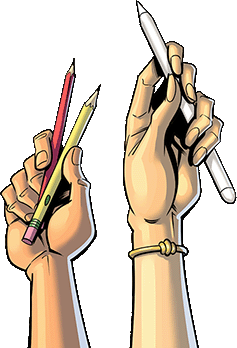The Graphic Novel is a Perfect Teachable Format
August 9, 2021
English teachers jumped on the graphic novel bandwagon early, sending students home with graphic novel versions of the classics. Now, other subject teachers are beginning to understand the benefits of the comic book format.
If you teach a complex or abstract topic in your classroom, and you have some artistic talent, you may want to consider creating your own graphic novels to teach it because the research is clear: graphic novels are the perfect teachable format for modern students.
Benefits of Graphic Novels
While many parents initially balk at the idea of their child reading graphic novels because they think it’s too easy, graphic novels have several benefits.
Graphic novels are approachable for modern kids, especially struggling readers
Many students already read graphic novels because they are often visual learners. Children today are experts at processing visual media because they are surrounded by it: video games, TV shows, movies, and smartphone apps. 90% of what our brains process in a day is visual.
Students who struggle with reading see pages of a text as a block of incomprehensible words, but they see the panels of a graphic novel as broken-up pieces of information, making them much less overwhelming.
Graphic novels make complex text more understandable
Topics like Shakespeare are hard to read. Truly understanding all those thees and thous, awkward sentence structures, and outdated references requires a level of familiarity reserved for experts. Yet, we expect our students to understand them on the first try in ninth grade.
Students can read a graphic novel version of Shakespeare and have a much better chance of comprehending it because the pictures show the meaning and context of the language. It’s the same reason why your flashcards often include images rather than words when you learn a new language.
Graphic novels require a different set of skills that makes it more likely people will retain the information
Whenever you can use more than one part of your brain, information is more likely to move from short-term to long-term memory. Reading graphic novels requires you to interpret the artist’s use of color, foregrounding, backgrounding, panel structures, lines, and other artistic choices that a reader needs to process while reading the words.
We process textual information in Broca’s Area and Wernicke’s Area, in the frontal cortex. When we process visual and textual information simultaneously like we do when reading graphic novels, the addition of the occipital lobe makes it more likely we will retain the information.
In English class, graphic novels include all the same elements as traditional story forms with visual images like in a movie
Reading a graphic novel is like reading a book and watching a movie simultaneously. It can be argued that reading a graphic novel is more rigorous than either reading a traditional story form or watching a movie.
Some English teachers use graphic novels to teach these elements, like foreshadowing, character development, and allusions, so that students can learn the elements without the added pressure of reading. Then, when they read a traditional story format, like a novel or play, they can focus on reading the text and find the story elements more easily.

Cross-Curriculum Graphic Novels
Graphic novels aren’t just for English class! Graphic novels are perfect for teaching history because they can bring historical events to life in a textbook. Graphic novels like John Lewis’s March series can help students see historical events as events with real people rather than disembodied names on a page.
Often students who struggle to comprehend jargon-heavy topics in science can benefit from a graphic novel format rather than a textbook. Students who lack confidence in their reading skills are easily overwhelmed by blocks of text. Abstract ideas, like chemical reactions, and multisyllabic science words like stoichiometry, often mean that students give up before they even start.
Graphic novels simplify complex scientific concepts and principles into their basic elements, breaking up information into easily memorable pieces.
Are You a Teacher Interested in Designing Graphic Novels to Teach Your Subject?
Comix Well Spring can help you engage your class and teach complex topics. We print and bind comic books and graphic novels using a broad range of printing options, including saddle stitch bindings or square bound paperbacks, both of which are durable enough for the classroom.
If you’ve put together a graphic novel to teach a skill in your classroom, the low minimum quantities at Comic Well Spring mean you can print a small run just for your classroom or print a more extensive run to share with colleagues.


